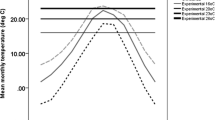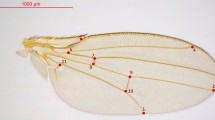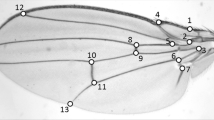Abstract
The second chromosome of Drosophila mediopunctata is highly polymorphic for inversions. Previous work reported a significant interaction between these inversions and collecting date on wing size, suggesting the presence of genotype-environment interaction. We performed experiments in the laboratory to test for the joint effects of temperature and chromosome inversions on size and shape of the wing in D. mediopunctata. Size was measured as the centroid size, and shape was analyzed using the generalized least squares Procrustes superimposition followed by discriminant analysis and canonical variates analysis of partial warps and uniform components scores. Our findings show that wing size and shape are influenced by temperature, sex, and karyotype. We also found evidence suggestive of an interaction between the effects of karyotype and temperature on wing shape, indicating the existence of genotype-environment interaction for this trait in D. mediopunctata. In addition, the association between wing size and chromosome inversions is in agreement with previous results indicating that these inversions might be accumulating alleles adapted to different temperatures. However, no significant interaction between temperature and karyotype for size was found––in spite of the significant presence of temperature––genotype (cross) interaction. We suggest that other ecological factors––such as larval crowding––or seasonal variation of genetic content within inversions may explain the previous results.



Similar content being viewed by others
Abbreviations
- ANOVA:
-
Analysis of variance
- CVA:
-
Canonical variates analysis
- CS:
-
Centroid size
- MS:
-
Mean square
- MANOVA:
-
Multivariate analysis of variance
- RW:
-
Relative warp
- RWA:
-
Relative warp analysis
References
Adams DC, Rohlf FJ, Slice DE (2004) Geometric morphometrics: ten years of progress following the revolution. Ital J Zool 71:5–16
Ananina G, Peixoto AA, Souza WN et al (2002) Polytene chromosome map and inversion polymorphism in Drosophila mediopunctata. Mem Inst Oswaldo Cruz 97:691–694
Ananina G, Peixoto AA, Bitner-Mathé BC et al (2004) Chromosomal inversion polymorphism in Drosophila mediopunctata: seasonal, altitudinal, and latitudinal variation. Genet and Molec Biol 27:61–69
Atkinson D, Sibly RM (1997) Why are organisms usually bigger in colder environments? Making sense of a life history puzzle. Trends Ecol Evol 12:235–239
Azevedo RB, French V, Partridge L (2002) Temperature modulates epidermal cell size in Drosophila melanogaster. J Insect Physiol 48:231–237
Bitner-Mathé BC, Klaczko LB (1999) Size and shape heritability in natural populations of Drosophila mediopunctata: temporal and microgeographical variation. Genetica 105:35–42
Bitner-Mathé BC, Peixoto AA, Klaczko LB (1995) Morphological variation in a natural population of Drosophila mediopunctata: altitudinal cline, temporal changes and influence of chromosome inversions. Heredity 75:54–61
Bookstein FL (1989) Principal warps: Thin-plate splines and the decomposition of deformations. IEEE Trans Patt Anal Mach Intell 11:567–585
Bookstein FL (1991) Morphometric tools for landmark data. Cambridge University Press, Cambridge
Calboli FC, Gilchrist GW, Partridge L (2003) Different cell size and cell number contribution in two newly established and one ancient body size cline of Drosophila subobscura. Evolution 57:566–573
Calboli FCF, Kennington WJ, Partridge L (2003) QTL mapping reveals a striking coincidence in the positions of genomic regions associated with adaptive variation in body size in parallel clines of Drosophila melanogaster on different continents. Evolution 57:2653–2658
Cavicchi S, Guerra D, Giorgi G et al (1985) Temperature-related divergence in experimental populations of Drosophila melanogaster. I. Genetic and developmental basis of wing size and shape variation. Genetics 109:665–689
Crill WD, Huey RB, Gilchrist GH (1996) Within and between-generation effects of temperature on the morphology and physiology of Drosophila melanogaster. Evolution 50:1205–1218
David JR, Moreteau B, Gauthier JR et al (1994) Reaction norms of size characters in relation to growth temperature in Drosophila melanogaster: an isofemale lines analysis. Genet Sel Evol 26:229–251
David JR, Gibert P, Gravot et al (1997) Phenotypic plasticity and developmental temperature in Drosophila: analysis and significance of reaction norms of morphometrical traits. J Therm Biol 22:441–451
David JR, Legout H, Moreteau B (2006) Phenotypic plasticity of body size in a temperate population of Drosophila melanogaster: when the temperature-size rule does not apply. J Genet 85:9–23
Debat V, Begin M, Legout H, David JR (2003) Allometric and nonallometric components of Drosophila wing shape respond differently to developmental temperature. Evolution 57:2773–2784
Dobzhansky Th, Pavan C (1943) Studies on Brazilian Species of Drosophila. Bol Faculd Fil Cienc Letr S Paulo 36:7–72
Dryden IL, Mardia KV (1998) Statistical shape analysis. John Wiley & Sons, Chichester
Falconer DS (1981) Introduction to quantitative genetics, 2nd edn. Longman, London
Fanara JJ, Hasson E, Rodriguez C (1997) The effect of polymorphic inversions on body size in two natural populations of Drosophila buzzatii from Argentina. Hereditas 126:233–237
Griffiths JA, Schiffer M, Hoffmann AA (2005) Clinal variation and laboratory adaptation in the rainforest species Drosophila birchii for stress resistance, wing size, wing shape and development time. J Evol Biol 18:213–222
Hasson E, Fanara JJ, Rodriguez C et al (1992) The evolutionary history of Drosophila buzzatii. XXIV. Second chromosome inversions have different average effects on thorax length. Heredity 68:557–563
Hatadani LM, Baptista JC, Souza WN et al (2004) Colour polymorphism in Drosophila mediopunctata: genetic (chromosomal) analysis and nonrandom association with chromosome inversions. Heredity 93:525–534
Hoffmann AA, Sgrò CM, Weeks AR (2004) Chromosomal inversion polymorphisms and adaptation. Trends Ecol Evol 19:482–488
Imasheva AG, Bubli OA, Lazebny OE et al (1995) Geographic differentiation in wing shape in Drosophila melanogaster. Genetica 96:303–306
Iriarte PF, Céspedes W, Santos M (2003) Quantitative-genetic analysis of wing form and bilateral asymmetry in isochromosomal lines of Drosophila subobscura using Procrustes methods. J Genet 82:95–113
Iriarte PF, Norry FM, Hasson ER (2003) Chromosomal inversions effect body size and shape in different breeding resources in Drosophila buzzatii. Heredity 91:51–59
Kastritsis CD (1966) Cytological studies on some species of the tripunctata group of Drosophila. Univ Texas Publs Stud Genet 6615:413–474
Klaczko LB (1995) Population genetics of Drosophila mediopunctata. In: Levine L (ed) Genetics of natural populations: the continuing importance of Theodosius Dobzhansky. Columbia University Press, New York
Klaczko LB (2006) Evolutionary genetics of Drosophila mediopunctata. Genetica 126:43–55
Lessells CM, Boag PT (1987) Unrepeatable repeatabilities: a commom mistake. Auk 104:116–121
Orengo DJ, Prevosti A (2002) Relationship between chromosomal polymorphism and wing size in a natural population of Drosophila subobscura. Genetica 115:311–318
Partridge L, Barrie B, Fowler K et al (1994) Evolution and development of body size and cell size in Drosophila melanogaster in response to temperature. Evolution 48:1269–1276
Peixoto AA, Klaczko LB (1991) Linkage disequilibrium analysis of chromosomal inversion polymorphisms of Drosophila. Genetics 129:773–777
Petavy G, Moreteau B, Gibert P et al (2001) Phenotypic plasticity of body size in Drosophila: effects of a daily periodicity of growth temperature in two sibling species. Physiol Ent 26:351–361
Robertson FW (1987) Variation of body size within and between wild populations of Drosophila buzzatii. Genetica 72:111–125
Rodríguez-Trelles F (2003) Seasonal cycles of allozyme-by-chromosomal-inversion gametic disequilibrium in Drosophila subobscura. Evolution 57:839–848
Rohlf FJ (1990) Rotational fit (Procrustes) methods. In: Rohlf FJ, Bookstein FL (eds) Proceedings of the Michigan morphometrics workshop, special publication No 2. University of Michigan Museum of Zoology, Ann Arbor
Rohlf FJ (1998) NTSYSpc numerical taxonomy and multivariate analysis system version 2.10. Exeter Software, Setauket
Rohlf FJ (2003) tpsRelw, relative warp analysis, version 1.29. Department of Ecology and Evolution, State University of New York at Stony Brook
Rohlf FJ, Marcus LF (1993) A revolution in morphometrics. Trends Ecol Evol 8:129–132
Ruiz A, Santos M, Barbadilla A et al (1991) Genetic variance for body size in a natural population of Drosophila buzzatii. Genetics 128:739–750
Santos M, Céspedes W, Balanyà J et al (2006) Temperature-related genetic changes in laboratory populations of Drosophila subobscura: evidence against simple climatic-based explanations for latitudinal clines. Am Nat 165:258–273
Thomas RH (1993) Ecology of body size in Drosophila buzzatii: untangling the effects of temperature and nutrition. Ecol Entomol 18:84–90
Val FC, Vilela CR, Marques MD (1981) Drosophilidae of neotropical region. In: Ashburner M, Carson HC, Thompson Jr JN (eds) The genetics and biology of drosophila, vol 3a. Academic Press, London
Von Zuben FJ, Duarte LC, Stangenhaus G, Pessôa LM, Reis SF (1998) Bootstrap confidence regions for canonical variates: application to studies of evolutionary differentiation. Biom J 40:327–339
Yadav JP, Singh BN (2003) Population genetics of Drosophila ananassae: inversion polymorphism and body size in Indian geographical populations. J Syst Evol Res 41:217–226
Weeks AR, McKechnie SW, Hoffmann AA (2002) Dissecting adaptive clinal variation: markers, inversions and size/stress associations in Drosophila melanogaster from a central field population. Ecol Lett 5:756–763
Acknowledgements
We thank Wilma N. Souza and Maria Aparecida Ramos Libânio for technical help. Mariana Lúcio Lyra helped us with figure drawing and Ted Hogan reviewed the English version of the manuscript. We thank Izabella Mendes Hatadani for important help with the statistical analysis; Fernando Von Zuben for statistical advices and help on the use of Matlab software; and Prof. F. James Rohlf for statistical suggestions. We also thank two anonymous reviewers and particularly Dr. William Etges (the Associate Editor) for suggestions that greatly improved this paper. This work was supported by Conselho Nacional de Desenvolvimento Científico e Tecnológico (CNPq), Fundação de Amparo à Pesquisa de São Paulo (FAPESP) and Coordenação de Aperfeiçoamento de Pessoal de Nível Superior (CAPES).
Author information
Authors and Affiliations
Corresponding author
Rights and permissions
About this article
Cite this article
Hatadani, L.M., Klaczko, L.B. Shape and size variation on the wing of Drosophila mediopunctata: influence of chromosome inversions and genotype-environment interaction. Genetica 133, 335–342 (2008). https://doi.org/10.1007/s10709-007-9217-7
Received:
Accepted:
Published:
Issue Date:
DOI: https://doi.org/10.1007/s10709-007-9217-7




